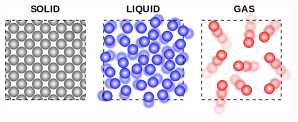In part 1, From Chaos to Calm, I talked about how the first step in healing is creating stabilization. Stabilizing symptoms might feel like the end-goal for some, but there’s much more healing that’s possible.
In this blog, I’ll tell you what comes next, but I’ll warn you in advance: I’m describing in a somewhat linear way a process that is not linear – it’s organic (like us!).
The next phase is what I’m calling reintegration. It actually starts to show up during the stabilization phase, like when you make popcorn – you’re waiting for the oil to heat the kernels and ping! ping! ping! A few pops happen before the popping really gets going.
It’s also a lot like water molecules.
 When we start, there are parts of us that are stuck and rigid, like ice cubes (“dorsal vagal”). This can be parts of the body, access to emotions, symptoms, etc.
When we start, there are parts of us that are stuck and rigid, like ice cubes (“dorsal vagal”). This can be parts of the body, access to emotions, symptoms, etc.
We add some “heat” to the stuck places as we bring attention, awareness (and in my case, touch) to the area. The molecules start to move, become less ordered and bounce around, making it feel more like fluid.
In that period when people are moving out of freeze, it is common for fight and flight (sympathetic) responses to appear, as a (hopefully) temporary time until the fluid state of “social engagement” becomes available more often.
This social engagement phase (“ventral vagal”) is a state of greater ease and ability to be present. It’s the state that allows for curiosity, creativity and genuine connection. It also allows people to respond more effectively to day-to-day stress.
G as or vapor in this metaphor would be a “too much state” – there’s not enough relationship between the elements.
as or vapor in this metaphor would be a “too much state” – there’s not enough relationship between the elements.
Important to note: During healing periods, it’s common to fluctuate between all the states until things settle.
As someone moves from a “frozen” state to a more fluid one, funny things start to happen:
- In the body, it could mean they start to feel interesting, unusual sensations, like tingling, buzzing, vibrating or twitching. Heat is also common. Muscles might feel like they “let go.”
- Symptoms that didn’t improve during the stabilization phase might start to shift now.
- Here’s the funniest one: things start to change in a person’s life. Relationships, how they show up in the world, what they find themselves accomplishing – many areas of their lives progress where they’d been stuck before.
Often, it’s a pretty smooth transition. Sometimes there are bumps along the way.
When we come out of “freeze,” and into fight or flight, whatever was held or incomplete will surface in order to move through, but thanks to the work in the stabilization phase, there’s more likelihood that the system can tolerate the shift.
For me, a big part of coming out of freeze was about connecting to anger in a healthy way.
The first stage was –
Me: “I feel like I’ve been really angry lately.”
SE Practitioner (SEP): “How have you noticed it?”
Me: “It’s like I’m getting road rage. I’m yelling at people when I drive – not that they’d know, but I’m calling them all sorts of things from the privacy of my car.”
SEP: “Yeah, well, you’re not acting out on the anger; you’re not hurting anyone. I think you should let that happen, and see what happens next.”
Me: [Nodding and thinking this was really strange advice, because surely this meant something was wrong with me.]
The second stage was a little more challenging. There was a person who was working with me on a project with a group of colleagues, and she really irritated me. I also wanted the leaders of the project to challenge her behavior but because of sensitive relationships, they did this very quietly (and it took a lot longer than I wanted.)
Me: “The anger thing is getting worse.”
SEP: “Oh? How so?”
Me: “We had a meeting for my project and, in front of my boss and boss’s boss, I yelled at this woman and stormed out.”
SEP: “You yelled at the woman and stormed out? Huh. What kinds of things did you say?”
Me: “Well, I challenged her about the role she was taking and said the things I wished my bosses would have said. Then I said, I have to step outside, and I took a walk around the block until the meeting ended and came back after she left.”
SEP: “WOW! You challenged her and then you left and went for a walk.”
Me: “Yes, I was shaking and so enraged, and I was afraid I’d get myself into trouble, so I left.”
My wonderful SEP pointed out that I hadn’t in fact said anything out-of-bounds, but I had let go of the “over-control” that had kept me locked up for many years. I came out of freeze and moved into fight and then flight. When I took my walk, I discharged (shaking, ragged breath, heat) until I was done. I allowed some of those left over responses to complete by giving them time and space to do what they needed to do.
From that time on, my feeling of “out-of-control” anger was done, and I found it was easier to stand my ground and not be so afraid of confrontation. I feel grateful for colleagues who didn’t come down on me for my anger, so that my fight response wasn’t thwarted. I’m even grateful to the person who challenged me, so this phase could move through.
In my experience, this reintegration phase continues and more and more layers get worked with. Those interested in continued excavation and growth keep going and find new possibilities for themselves. Others reach a point that feels like enough of the symptoms have shifted and they’re ready to stop, but the shifts they got stay with them.
 We use the infinity symbol to represent integration. Think of it as a weaving back together; a coming back to our wholeness.
We use the infinity symbol to represent integration. Think of it as a weaving back together; a coming back to our wholeness.
Hope you find the healing you’re looking for.
Your turn:
- Did you have a “coming out of freeze” experience in your healing?
For more information on my work, go to https://www.brandyvanderheiden.com


